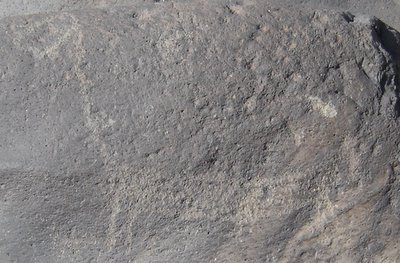One of the first questions I asked our tour guides at Little Petroglyph Canyon was if they knew where any petroglyphs like this might be. I was directed to this one.
 The petroglyph below the rectilinear figure and above the green lichen is thought by many to look like a mammoth. I think it has possibilities but is sort of an ambiguous figure. The main problem I had with it was that it didn't look any more patinated that any of the other figures around it - though again this is a subjective judgement.
The petroglyph below the rectilinear figure and above the green lichen is thought by many to look like a mammoth. I think it has possibilities but is sort of an ambiguous figure. The main problem I had with it was that it didn't look any more patinated that any of the other figures around it - though again this is a subjective judgement.
Clambering around the canyon alone, I did find this interesting petroglyph myself up near the north end.
 This may be a little difficult for you to see, partly because it did look very heavily patinated, therefore perhaps older, than the other petroglyphs around it. I have a cropped version here, that may make it easier to see.
This may be a little difficult for you to see, partly because it did look very heavily patinated, therefore perhaps older, than the other petroglyphs around it. I have a cropped version here, that may make it easier to see. I see an animal with an oval head in the upper left-hand corner of the frame, that has a long neck shown as a single line, connecting to a rectilinear body. The body has a flat back, four proportionally short legs, and a short, bobbed tail. I have asked a number of folks for their opinions, but I think this could represent some sort of camelid, likely a llama.
I see an animal with an oval head in the upper left-hand corner of the frame, that has a long neck shown as a single line, connecting to a rectilinear body. The body has a flat back, four proportionally short legs, and a short, bobbed tail. I have asked a number of folks for their opinions, but I think this could represent some sort of camelid, likely a llama.
 How does it look to you? I think the neck is too long and the legs and tail too short to be a horse. I think the back is too flat and the legs too short to be a camel.
How does it look to you? I think the neck is too long and the legs and tail too short to be a horse. I think the back is too flat and the legs too short to be a camel.
Llamas were common here in California during the Pleistocene (as were camels), with two species, the stout-legged llama (Paleolama mirifica) and the large-headed llama (Hemiauchenia macrocephala) present in the Rancholabrean fauna. Both became extinct about 10,000 years ago - making this petroglyph at least that old if it represents one.
I sent this picture to a couple of people knowledgeable of Coso rock-art to check if they had seen it and what their opinion was but have not gotten a reply yet. A hundred feet or so down the canyon I saw this petroglyph.
 It is one of very few (I saw two others) historic pieces of graffiti in the area. Of course, some may think this representation of Model-T culture is very old.
It is one of very few (I saw two others) historic pieces of graffiti in the area. Of course, some may think this representation of Model-T culture is very old.
1 comment:
It's the opinion of some experts on the Blackfeet language that the word "stumik" which is now often used to mean bull, or at least big powerful male, was once the name for Mammoths. Yet another trace of the past showing up today, almost unnoticeably. I don't know how they drew their conclusion.
Prairie Mary
Post a Comment